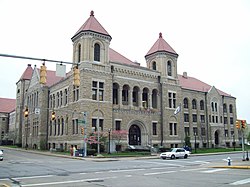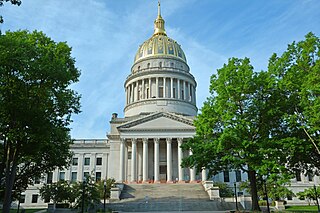
The West Virginia State Capitol is the seat of government for the U.S. state of West Virginia, and houses the West Virginia Legislature and the office of the Governor of West Virginia. Located in Charleston, West Virginia, the building was dedicated in 1932. Along with the West Virginia Executive Mansion it is part of the West Virginia Capitol Complex, a historic district listed on the National Register of Historic Places.
Institute is an unincorporated community on the Kanawha River in Kanawha County, West Virginia, United States. Interstate 64 and West Virginia Route 25 pass by the community, which has grown to intermingle with nearby Dunbar. As of 2018, the community had a population of 1,489, 54% of whom were African American.

Kanawha State Forest is a 9,300-acre (38 km2) recreation area located near the community of Loudendale, West Virginia, which is about 7 miles (11 km) from downtown Charleston, West Virginia, United States. It is managed by the West Virginia Department of Natural Resources.

The Marion County Courthouse is a Beaux-Arts style building in Fairmont, West Virginia, in the United States. The courthouse was constructed from 1897 to 1900, and was designed by the architectural firm of Yost & Packard of Columbus, Ohio. Its dome is topped by a figure carrying the scales of justice.

Charleston station is an active intercity railroad station in Charleston, Kanawha County, West Virginia. Located on MacCorkle Avenue Southeast, the station services trains of Amtrak's Cardinal between New York Penn Station and Chicago Union Station. The two trains, make stops in Charleston on Wednesdays, Fridays and Sundays. Charleston station contains a single 800-foot (240 m) concrete side platform and has a station depot that provides a waiting room for customers.
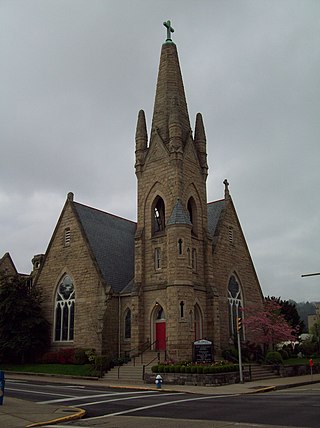
St. John's Episcopal Church is an historic Episcopal church located at 1105 Quarrier Street in Charleston, West Virginia, in the United States. On November 2, 1989, it was added to the National Register of Historic Places. It was also listed as a contributing property in the Downtown Charleston Historic District in 2006.

London is an unincorporated community in Kanawha County in the U.S. state of West Virginia, located 25 miles from the state capital of Charleston. London Lock and Dam, operated by US Army Corps of Engineers is located here on Kanawha River.
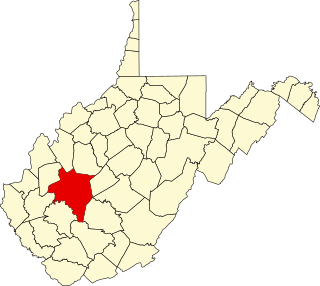
This is a list of the National Register of Historic Places listings in Kanawha County, West Virginia.

Breezemont, also known as the Gen. C. C. Watts House, is a historic home located at Charleston, West Virginia. It was built about 1905 for Cornelius Clarkson Watts (1848–1930) an individual who contributed quite significantly to the history of both Kanawha County and the state of West Virginia. It is located atop Watts Hill overlooking much of Charleston, and is an example of vernacular Neo-Classical architecture.

Bougemont is a historic home located at Charleston, West Virginia. It was the home of two prominent families in Charleston's business development. It was built about 1916 by Harrison Brooks Smith, an attorney, who served as president of Kanawha Banking and Trust and various companies in Kanawha County. Smith died in 1942, and in 1959, Horace Hamilton Smallridge, another leading Charleston businessman, purchased the property. Bougemont is symmetrically arranged with a 2+1⁄2-story central block and two single-story side wings. The entrance facade features a pedimented portico with Corinthian columns. Also on the property are a cottage, stable, and barn.

Craik-Patton House is a historic home and public museum located at Charleston, West Virginia. It was built by James Craik and his wife, Juliet Shrewsbury, in 1834 in the Greek Revival style. It was originally located on Virginia Street in Charleston, but moved to its present site in 1973 to save it from the threat of demolition. It features four massive columns that support the extended center roof with pilasters placed above the front facade. It was faithfully restored and preserved for the public by the National Society of the Colonial Dames of America in the state of West Virginia and open for tours year round.

Laidley-Summers-Quarrier House, also known as Glenwood, is a historic home located at Charleston, West Virginia. It is a two-story gable roofed dwelling in the Greek Revival style and built in 1852.

Littlepage Stone Mansion, also known as The Old Stone Mansion, is a historic home located at Charleston, West Virginia. It was constructed in 1845 is one of only six houses within the City of Charleston that date to before the American Civil War. It was originally constructed as a two-story Federal style residence, with additions and improvements made in 1915 and 1936.

Sunrise, also known as MacCorkle Mansion, is a historic home located at Charleston, West Virginia. It was built in 1905 by West Virginia's ninth governor, William A. MacCorkle (1857-1930). It is a long, three-story stone mansion. Its gabled roof is dotted with dormers and chimneys and surmounts an intricate, but wide, cornice which gives the illusion that the house is smaller than it actually is. The Georgian structure rests on a bluff overlooking the Kanawha River, and from the northern portico one can see nearly the entire city of Charleston. The north side features four magnificent Doric, or neo-classic, columns which support the cornice and ashlar-finished pediment. In 1961 Sunrise Foundation, Inc., was formed for the purpose of purchasing the mansion and grounds.
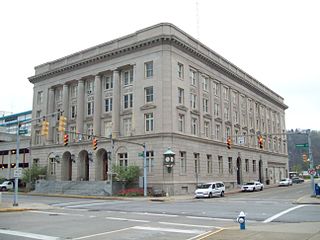
Charleston City Hall is a historic city hall located at Charleston, West Virginia. It was constructed in 1921 in the Neoclassical style. It is located opposite the Kanawha County Courthouse, at the center of downtown Charleston. The major, or entrance, elevation faces Virginia Street with monumental design features and walls clad in smooth gray limestone. The equally impressive limestone-faced Court Street facade presents a grand prospect which runs southward for nearly a block between Virginia Street and Kanawha Boulevard. These two elevations are entirely formal in design because they were intended to face the courthouse and principal city thoroughfare. The four-story building is centered with a colossal engaged colonnade of six fluted Doric columns, which rises three-stories in support of a massive cornice. The interior features a grand entrance lobby, and classically designed stairhall and council chambers.
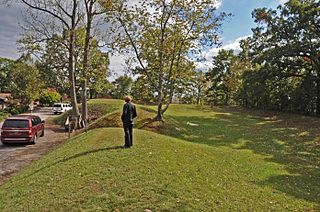
Fort Scammon, also known as Camp White or Fort Hill, is an archaeological site in Charleston in Kanawha County, West Virginia. The site preserves earthenwork battlements that were set up in 1863 in an elliptical pattern. The period of significance during the American Civil War coincides with the period of late summer in 1862 when Confederate artillery fired from the area and the year or so after March 1863 when Union troops fortified the heights.
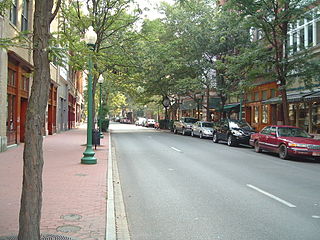
Downtown Charleston Historic District is a national historic district located at Charleston, West Virginia, USA. The district contains contributing structures in the Late Victorian and Late 19th and 20th Century Revivals architectural styles. St. John's Episcopal Church (1884), the Basilica of the Co-Cathedral of the Sacred Heart (1897), and Woodrums' Building (1916) are contributing properties.

The West Virginia Capitol Complex is an 18-acre (7.3 ha) historic district located along Kanawha Blvd., E., in Charleston, West Virginia. It dates from 1925 and was listed on the National Register of Historic Places in 1974.
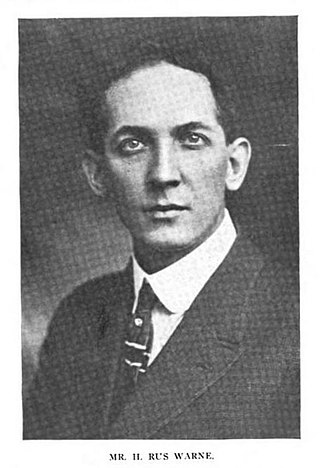
Harry Rus Warne was a Charleston, West Virginia-based architect.

Haddad Riverfront Park is a municipal park along the Kanawha River in Charleston, Kanawha County in the U.S. state of West Virginia. It is named for Fred Haddad, a prominent Arab-American businessman from West Virginia.
